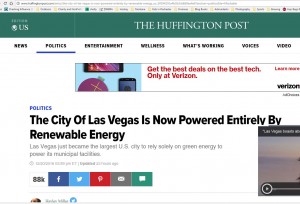Now, reporters don’t usually write their own headlines, but this is just out there:
Here is the longer piece. The headline makes it appear that all 600,000 residents of Las Vegas are getting solar power. Of course, you have to read the fine print that tells us only all municipal facilities are using renewable energy. That’s a pretty significant difference.
But the real elfin magic being played here is this: even if the solar farms we are talking about produced enough gross electricity to match the electricity demands of the entire city, it is not at all the case that the city would be “powered entirely by green energy.”
How?
- Green energy itself may not be green. Lest I bore you with a long lecture on solar (my Eco 238 students got to sleep through it), production of solar panels requires toxic materials, uses energy, and so on. The sites for solar panels must be cleared, wildlife must be intruded upon and so on. The solar panels must be maintained, and in fact cleaned, which requires water, something that is not exactly in abundance out in the Vegas desert. And so on. And solar panels do not last forever. The replacement times are different for different materials, but it is not clear that they are on net much “greener” than what they may be replacing (more on that below).
- Solar panels provide intermittent power, and therefore require battery backup. Those batteries are not green.
- Does the author, or any analysis of “green” energy, EVER demonstrate how much fossil fuel generation was taken offline because of the expansion of the green power? We can do this dynamically of course and ask how much fossil fuel electricity would have had to be added were we to not add the new green power, but nonetheless, do we ever see, “X kilowatt-hours of fossil fuel electricity did not have to be generated because Y kilowatt-hours of green energy were created” and how much environmental improvement we get from that?
- How does much of Las Vegas get its current electricity? My guess is from the Hoover Dam hydro. Hydro, now that it is already built, has almost zero environmental impact (the building of it did) at the margin. So IF the author wishes to celebrate the expansion of solar power in Las Vegas and it has reduced the amount of hydro we rely upon, trading off solar for already-built hydro would be worse for the environment. Perhaps the author will demonstrate that this reduction in Las Vegas hydro will now allow more of the Hoover hydro to be sold elsewhere and that those places can reduce their reliance on coal and gas?
- Of course, any “green” intermittent technology requires dispatchable backup. It may even be the case that adding “green” energy production will actually increase production due to the amount of “ungreen” idling capacity that has to be around to meet peak demands.
It must get tiring to have to move that energy elf around every day. When will the kids be old enough to learn the truth of the magic?

From my (limited) understanding, it takes days to shut down or start up a power plant. So the backups are truly running the whole time. I still have much more hope in solar being a reasonable energy source compared to wind though.
However, I can’t take anyone seriously that talks about this huge “energy problem” when they almost never suggest nuclear. It’s almost like this movement, “backed by scientific consensus”, isn’t based on science at all!
By the way, here’s a headline from the New York Times in 1984. Take from it what you will.
“A NEW COAL-BURNING PLANT OFFERS A GLIMPSE OF A NONNUCLEAR FUTURE”
http://www.nytimes.com/1984/11/05/nyregion/a-new-coal-burning-plant-offers-a-glimpse-of-a-nonnuclear-future.html
That was coming on the heels of government programs to SUPPORT more coal burning after nuclear scares of late 70s and energy crisis of 70s.
From my reading, it looks life various types of fast-breeder nuclear reactors are ready for prime-time. These are potential game-changers, to use corporate-speak, as they can burn recycled and spent fuel, they can “breed” their own fuel, they generate a lot less waste than light water reactors, are safer and also I think can cycle up more than traditional reactors and so can potentially replace a little more than the 40% baseload that we think their brethren are limited to.